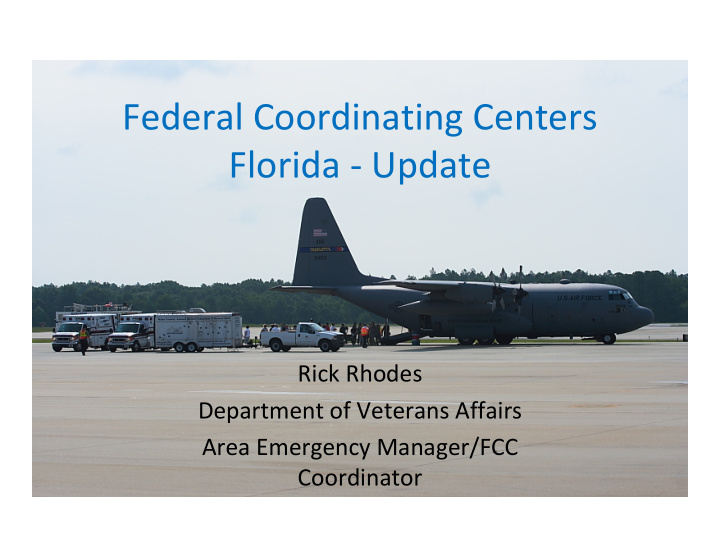



Federal Coordinating Centers Florida ‐ Update Rick Rhodes Department of Veterans Affairs Area Emergency Manager/FCC Coordinator
Tampa Primary Receiving Area (PRA)
FCC Tampa • James A. Haley VAMC • FCC Coordinator: Rick Rhodes • PRA ‐ Tampa International Air Port • Key Supporting Agencies: – Tampa Fire Rescue – Hillsborough County EOC – Hillsborough County DOH • NDMS Partner Hospitals ‐ 64 • Current Activities: NDMS MOA Updates, FCC/NDMS Steering Committee, Plan Rewrite, RNC patient movement planning with local, state, and federal partners, Plan Team Training FY 12
Miami Primary Receiving Area (PRA)
FCC Miami • Bruce W. Carter VAMC • FCC Coordinator: Jose Cintron • PRA ‐ United State Coast Guard Miami Air Station Opa ‐ Locka, FL • Key Supporting Agencies: – Miami Veterans Affairs Healthcare System – Miami ‐ Dade EOC – Miami ‐ Dade Police Department • NDMS Partner Hospitals ‐ 30 • Current Activities: NDMS MOA Update, Planning for Patient reception operations in coordination with local, state, and federal partners in support of RNC planning.
Jacksonville Primary Receiving Area (PRA)
FCC Jacksonville (DoD) • Naval Air Station Jacksonville (NAS JAX) • FCC Coordinator: Dana Shropshire • PRA ‐ Naval Air Station Jacksonville (NAS JAX) • Key Supporting Agencies: • NDMS Partner Hospitals ‐ 18 (16 Florida, 2 Georgia) Current Activities: Ensure the collaboration between all partners, make sure the NDMS facilities are provided the support needed and educate the community on NDMS as a whole, provide the complete picture from response teams to definitive care. Planning for patient reception operations with local, state, and federal partners in support of RNC activities.
National Disaster Medical System Definitive Medical Care Memorandum of Agreement (MOA) “What’s Different in the New MOA”
History What Prompted The Changes NDMS hospitals activated in response to recent hurricanes experienced limited support from the NDMS: - Sluggish reimbursements for medical expenses. - Lack of precise planning for discharged NDMS patients, including: - Locations to support discharged patients awaiting repatriation and - Transportation back to patients’ homes or points of origin.
Result Changes Made to the MOA • The new MOA draws upon these lessons learned and outlines an enhanced range of support that NDMS hospitals can expect from the NDMS federal partners. • MOA modifications made related to: Bed Availability HHS Service Access Teams Discharge Planning Reimbursement
Bed Availability • Old MOA: H ospitals provided a minimum and maximum number of beds they were willing to make available to NDMS. • New MOA: “The Provider agrees to report the number of beds available (e.g. in HAvBED) when requested to support NDMS exercises or operations and then make those beds available to the NDMS for patients in real ‐ life events. The FCC will assess the real ‐ time status of the reported beds prior to distributing inbound patients.”
HHS Service Access Teams HHS established Service Access Teams to deploy to all activated FCCs to: - Serve as “facilitators to ensure discharge planning is accomplished and human services support is provided to discharged patients and attendants evacuated through the NDMS.” - “Coordinate all aspects of patient return to ensure a smooth transition from the host state to the home state or other appropriate location.”
Discharge Planning HHS Service Access Teams will: • “Coordinate all patient movement activities and communicates with the patient movement contractor to arrange for transportation.” • “If transportation to a final destination is not possible when the patient is ready for discharge, HHS will establish locations to receive the discharged NDMS patients. These locations may include hotels, skilled nursing facilities, nursing homes, Federal Medical Stations, or general population shelters as appropriate.”
Reimbursement “Reimbursements, subject to the availability of appropriations, will be limited to care provided for: injuries or illnesses resulting directly from a specified public health emergency; injuries, illnesses and conditions requiring essential medical services necessary to maintain a reasonable level of health temporarily not available as a result of the public health emergency; or injuries or illnesses affecting authorized emergency response and disaster relief personnel responding to the public health emergency. HHS, as payer, will define what constitutes an “NDMS patient”.”
Reimbursement HHS Assistant Secretary for Preparedness & Response has pledged speedy reimbursements. The following table identifies the various sources of funding for reimbursement and the order of payment. Patient’s Insurance Status Provider will first bill Provider will bill secondly NDMS status for payments Uninsured NDMS Covered at 110% Medicare rate Medicaid NDMS Covered at 110% Medicare rate Other insurance or health Other Insurance NDMS for balance, not to exceed *Covered at 110% Medicare rate when program coverage (other than 110% Medicare rate combined with private insurance Medicaid, Medicare, or TRICARE) Medicare Medicare Not eligible TRICARE Per TRICARE Not eligible
Reimbursement “NDMS payment will end when one of the following • occurs, whichever comes first: completion of medically indicated treatment as defined by the Centers for Medicare and Medicaid Services diagnostic related group, based on ICD-9 (and ICD-10 when available) codes (maximum of 30 days); voluntary refusal of care; return to originating facility or other location for follow on care.” NDMS will provide reimbursements, subject to the • availability of appropriations, for the same type of services covered under the Medicare benefit packages provided to authorized NDMS patients by qualified Medicare health care providers.
MOA Implementation • The Agreement becomes effective upon signature of one of the NDMS Federal Partners and the Provider Hospital. • The MOA may be canceled at any time by mutual written consent. Unless otherwise noted, the MOA remains in effect for a period not to exceed five years. • NDMS hospitals also agree to participate in joint Federal Coordinating Center exercises, designed to meet external disaster standards established by applicable accrediting bodies.
NDMS Definitive Medical Care MOA Questions?
Recommend
More recommend